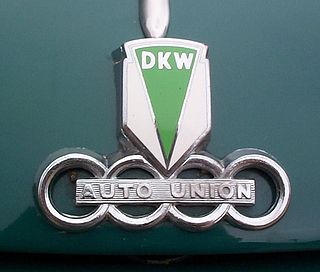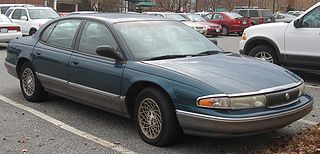
DKW is a German car and motorcycle marque. DKW was one of the four companies that formed Auto Union in 1932 and is hence an ancestor of the modern day Audi company.

The Standard Motor Company Limited was a motor vehicle manufacturer, founded in Coventry, England, in 1903 by Reginald Walter Maudslay. It purchased Triumph in 1945 and in 1959 officially changed its name to Standard-Triumph International and began to put the Triumph brandname on all its products.

James & Browne was a British automobile manufacturer, based in Hammersmith, London between 1898 and 1910.

The Chrysler New Yorker is an automobile model which was produced by Chrysler from 1940 to 1996, serving for several years as the brand's flagship model. A trim level named the "New York Special" first appeared in 1938 and the "New Yorker" name debuted in 1939. The New Yorker name helped define the Chrysler brand as a maker of upscale models, priced and equipped above mainstream brands like Ford, Chevrolet/Pontiac, and Dodge/Plymouth, but below full luxury brands like Cadillac, Lincoln and Packard. During the New Yorker's tenure, it competed against upper level models from Buick, Oldsmobile and Mercury. Until its discontinuation in 1996, the New Yorker had made its mark as the longest-running American car nameplate.

Argyll was a Scottish motor car marque manufactured from 1899 to 1932, and again from 1976 to around 1990.

Sunbeam Motor Car Company Limited was a British motor car manufacturer with its works at Moorfields in Blakenhall, a suburb of Wolverhampton in the county of Staffordshire, now West Midlands. Its Sunbeam name had been registered by John Marston in 1888 for his bicycle manufacturing business. Sunbeam motor car manufacture began in 1901. The motor business was sold to a newly incorporated Sunbeam Motor Car Company Limited in 1905 to separate it from Marston's pedal bicycle business; Sunbeam motorcycles were not made until 1912.

Singer Motors Limited was a British motor vehicle manufacturing business, originally a bicycle manufacturer founded as Singer & Co by George Singer, in 1874 in Coventry, England. Singer & Co's bicycle manufacture continued. From 1901 George Singer's Singer Motor Co made cars and commercial vehicles.

The Opel Commodore was an executive car (E-segment) produced by Opel from 1967 to 1982. It is the six-cylinder variant of the Rekord with styling differences. The Commodore nameplate was used by Opel from 1967 to 1982. However, its nameplate/lineage continues with the Australian Holden Commodore. The last generation was sold in the United Kingdom primarily as the Vauxhall Viceroy although Opel models were also sold.
The Lanchester Motor Company Limited was a car manufacturer located until early 1931 at Armourer Mills, Montgomery Street, Sparkbrook, Birmingham, and afterwards at Sandy Lane, Coventry England. The marque has been unused since the last Lanchester was produced in 1955. The Lanchester Motor Company Limited is still registered as an active company and accounts are filed each year, although as of 2014 it is marked as "non-trading".
The Austin Cambridge is a motor car range produced by the Austin Motor Company, in several generations, from September 1954 through to 1971 as cars and to 1973 as light commercials. It replaced the A40 Somerset and was entirely new, with modern unibody construction. The range had two basic body styles with the A40, A50, and early A55 using a traditional rounded shape and later A55 Mark IIs and A60s using Pininfarina styling.

Wolseley Motors Limited was a British motor vehicle manufacturer founded in early 1901 by the Vickers armaments combine in conjunction with Herbert Austin. It initially made a full range topped by large luxury cars and dominated the market in the Edwardian era. The Vickers brothers died and without their guidance Wolseley expanded rapidly after the war, manufacturing 12,000 cars in 1921, and remained the biggest motor manufacturer in Britain.

Stevens-Duryea was an American manufacturer of automobiles in Chicopee Falls, Massachusetts, between 1901 and 1915 and from 1919 to 1927.

The Austin 7 is an economy car that was produced from 1922 until 1939 in the United Kingdom by Austin. It was nicknamed the "Baby Austin" and was at that time one of the most popular cars produced for the British market and sold well abroad. Its effect on the British market was similar to that of the Model T Ford in the US, replacing most other British economy cars and cyclecars of the early 1920s. It was also licensed and copied by companies all over the world. The very first BMW car, the BMW Dixi, was a licensed Austin 7, as were the original American Austins. In France they were made and sold as Rosengarts. In Japan, Nissan also used the 7 design as the basis for their first cars, although not under licence. This eventually led to a 1952 agreement for Nissan to build and sell Austins in Japan under the Austin name.

The Rolls-Royce Silver Ghost name refers both to a car model and one specific car from that series.

The first Cadillac automobiles were the 1903 Model built in the last quarter, 1902. These were 2-seater "horseless carriages" powered by a reliable and sturdy 10 hp (7 kW) single-cylinder engine developed by Henry Martyn Leland and built by Leland and Faulconer Manufacturing Company of Detroit, of which Henry Leland was founder, vice-president and general manager.

Tidaholms Bruk was founded in the Middle Ages and over the years it merged with several smaller industries into woodworking and the making of carts. In the small community of Sandhem outside Tidaholm the brothers Gottfrid and David Lindström in 1895 had a workshop where they made Kronan bicycles. After a while Gottried got tired of making bicycles and went to USA to study the budding automobile industry and returned full of new ideas. He was a workaholic and he worked late into the nights to create the Tidaholmsbilen. Most of the parts were made within the works. Engine blocks and pistons in the foundry, the frame in the smithy, transmission in the mechanical workshop, woodwork in the wood workshop. In 1903 it was time for the first start attempt which was successful and the first Tidaholm car could roll out of the workshop under its own power.

Rolls-Royce was a British luxury car and later an aero engine manufacturing business established in 1904 by the partnership of Charles Rolls and Henry Royce. Building on Royce's reputation established with his cranes they quickly developed a reputation for superior engineering by manufacturing the "best car in the world". The First World War brought them into manufacturing aero engines. Joint development of jet engines began in 1940 and they entered production.

Sheffield-Simplex was a British car and motorcycle manufacturer operating from 1907 to 1920 based in Sheffield, Yorkshire, and Kingston upon Thames, Surrey.

Douglas was a British motorcycle manufacturer from 1907–1957 based in Kingswood, Bristol, owned by the Douglas family, and especially known for its horizontally opposed twin cylinder engined bikes and as manufacturers of speedway machines. The company also built a range of cars between 1913 and 1922.
Ivy was a motorcycle manufacturer between 1907 and 1934 in Birmingham, England. It was run by various brothers from the Newman family. Ivy built about 6,000 motorcycles of various models. Most used two-stroke engines made by either J.A.P. or Precision, but there were also 225cc and 296cc engines designed and manufactured by Ivy. The company also made its own suspension forks, carburettors and sidecars.




















